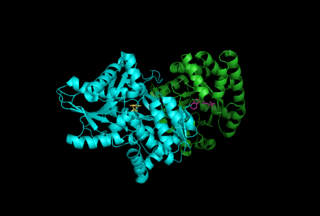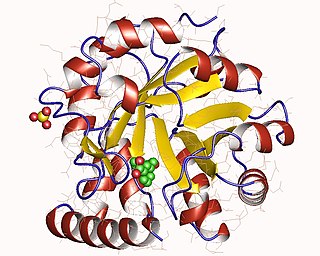
Tryptophan synthase or tryptophan synthetase is an enzyme that catalyses the final two steps in the biosynthesis of tryptophan. It is commonly found in Eubacteria, Archaebacteria, Protista, Fungi, and Plantae. However, it is absent from Animalia. It is typically found as an α2β2 tetramer. The α subunits catalyze the reversible formation of indole and glyceraldehyde-3-phosphate (G3P) from indole-3-glycerol phosphate (IGP). The β subunits catalyze the irreversible condensation of indole and serine to form tryptophan in a pyridoxal phosphate (PLP) dependent reaction. Each α active site is connected to a β active site by a 25 angstrom long hydrophobic channel contained within the enzyme. This facilitates the diffusion of indole formed at α active sites directly to β active sites in a process known as substrate channeling. The active sites of tryptophan synthase are allosterically coupled.
In enzymology, an indole-3-acetaldehyde oxidase (EC 1.2.3.7) is an enzyme that catalyzes the chemical reaction

The enzyme aminocyclopropane-1-carboxylic acid synthase catalyzes the synthesis of 1-Aminocyclopropane-1-carboxylic acid (ACC), a precursor for ethylene, from S-Adenosyl methionine, an intermediate in the Yang cycle and activated methyl cycle and a useful molecule for methyl transfer:
2-C-Methyl-D-erythritol 2,4-cyclodiphosphate synthase is a zinc-dependent enzyme and a member of the YgbB N terminal protein domain, which participates in the MEP pathway of isoprenoid precursor biosynthesis. It catalyzes the following reaction:
In enzymology, an indoleacetaldoxime dehydratase (EC 4.99.1.6) is an enzyme that catalyzes the chemical reaction
The enzyme 2,3-dimethylmalate lyase catalyzes the chemical reaction
4-amino-4-deoxychorismate lyase is an enzyme that participates in folate biosynthesis by catalyzing the production of PABA by the following reaction

The enzyme indole-3-glycerol-phosphate synthase (IGPS) (EC 4.1.1.48) catalyzes the chemical reaction
The enzyme indolepyruvate decarboxylase (EC 4.1.1.74) catalyzes the chemical reaction
In enzymology, an indoleacetate—lysine synthetase (EC 6.3.2.20) is an enzyme that catalyzes the chemical reaction
The enzyme abieta-7,13-diene synthase catalyzes the chemical reaction
The enzyme methylglyoxal synthase catalyzes the chemical reaction
In enzymology, a 1-deoxy-d-xylulose-5-phosphate synthase (EC 2.2.1.7) is an enzyme in the non-mevalonate pathway that catalyzes the chemical reaction
In enzymology, a N-acylneuraminate-9-phosphate synthase (EC 2.5.1.57) is an enzyme that catalyzes the chemical reaction
In enzymology, a digalactosyldiacylglycerol synthase is an enzyme that catalyzes the chemical reaction
In enzymology, an indole-3-acetate beta-glucosyltransferase is an enzyme that catalyzes the chemical reaction

Sphingosine-1-phosphate lyase 1 is an enzyme that in humans is encoded by the SGPL1 gene.
Indole-2-monooxygenase (EC 1.14.13.137, BX2 (gene), CYP71C4 (gene)) is an enzyme with systematic name indole,NAD(P)H:oxygen oxidoreductase (2-hydroxylating). This enzyme catalyses the following chemical reaction

The biosynthesis of benzoxazinone, a cyclic hydroxamate and a natural insecticide, has been well-characterized in maize and related grass species. In maize, genes in the pathway are named using the symbol bx. Maize Bx-genes are tightly linked, a feature that has been considered uncommon for plant genes of a biosynthetic pathways. Especially notable are genes encoding the different enzymatic functions BX1, BX2 and BX8 and which are found within about 50 kilobases. Results from wheat and rye indicate that the cluster is an ancient feature. In wheat the cluster is split into two parts. The wheat genes Bx1 and Bx2 are located in close proximity on chromosome 4 and wheat Bx3, Bx4 and Bx5 map to the short arm of chromosome 5; an additional Bx3 copy was detected on the long arm of chromosome 5B. Recently, additional biosynthetic clusters have been detected in other plants for other biosynthetic pathways and this organization might be common in plants.
Function Maize gene for first step in biosynthesis of benzoxazin, which aids in resistance to insect pests, pathogenic fungi and bacteria.





